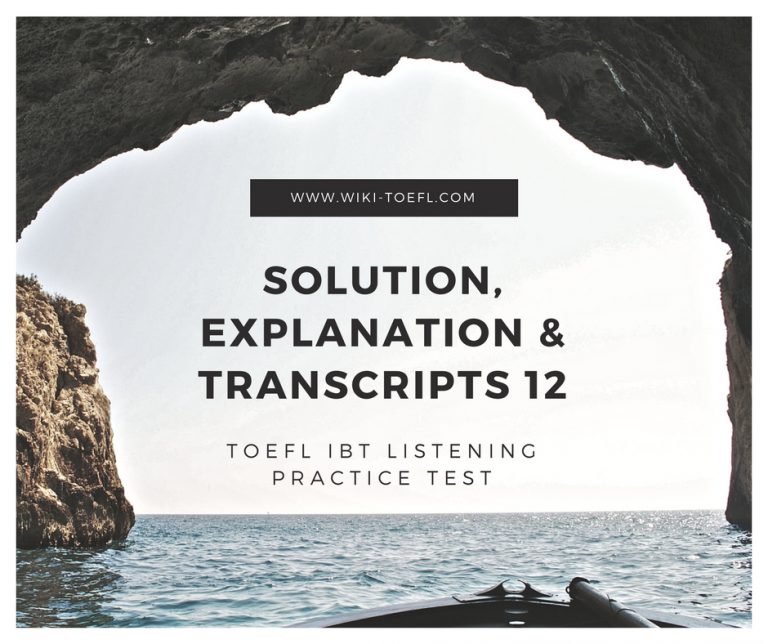TOEFL IBT Listening Practice Test 12 From Delta’s Key TOEFL Test Solution & Explanation
1. C
The woman is inquiring about writing arts reviews for the paper. She says …I’m interested in writing for the campus paper; I’m interested—I’d like to write arts reviews, stories about… concerts and films and events in the arts. (2.3)
2. D
The man’s purpose is to inform her that the paper does not need another reviewer. The woman wants to write arts reviews, but the man says they already have a couple of ‘journalism students who write reviews. He explains further by saying You see, we re not a big paper to start out with, and the administration just cut our funding, and there are lots of students who want to write for us, so I’m afraid it’s pretty competitive. (2.3)
3. A
The man means that he probably cannot offer her a job now. The woman wants to write reviews for the campus paper, but the man says he couldn’t guarantee anything (a job) at present. He explains further by saying …our budget was cut, and we had to reduce the size of our paper. (2.4)
4. C
The city newspaper is called The Clarion. The man says If you really want to write reviews, you should send something to The Clarion; They sometimes print reviews by students. (2.2)
5. D
The woman wants to write reviews for a newspaper, and the man advises her to send some of her writing to the city newspaper, The Clarion. The woman says Thanks! I really appreciate the information;
Actually, I would be very interested in writing book reviews. You can predict that she will contact the city newspaper about writing book reviews. (2.4)

6. C
The professor mainly discusses what causes the auroras. The professor says The auroras are the result of a complex interaction between the solar wind and the Earth’s magnetic field. Here s what happens. (2.1)
7. B, C
Red and green are commonly seen in the auroras. The professor says An early twentieth-century explorer wrote about the “bloody red” and “ghostly green ” lights; Most of the time they’re greenish—yellow, but sometimes they take colors from violet to red. (2.2)
8. C
The professor’s purpose is to point out where the auroras are most visible. The professor says They ’re most often seen near the North and South Poles…. (2.3)
9. A
The professor’s purpose is to explain how the auroras are electrical in nature. The student says it sounds kind of like electricity, and the professor responds by explaining how electricity is generated by the solar wind, carrying a stream of charged particles and moving across Earth’s magnetic field. (2.3)
10.
Yes: Oxygen and nitrogen atoms in the ionosphere become “excited”: …oxygen and nitrogen atoms in the ionosphere become “excited,” or ionized
No: Sunlight travels to Earth and is reflected back into space by clouds: Not mentioned in the lecture.
Yes: Ionized atoms de-energize and emit radiation as visible light: The auroras happen when these ionized atoms return to their normal state from their excited, energized states; …as they do so, they emit radiation. Part of this radiation is visible light….
Yes: The solar wind interacts with Earth’s magnetic field: The auroras are the result of a complex interaction between the solar wind and the Earth’s magnetic field. (2.6)
11. B
The professor says Oxygen releases either dark red or ghostly green. Nitrogen emits rosy pink or magenta. You can infer that the color of auroras is related to the type of gas involved. (2.4)
12. C
The professor describes political parties in a two-party system. The professor says The democratic institutions of these countries operate essentially on a two-party system. Why a two-party system? Or, should I say why has the two-party system prevailed in so many democratic states?; In every democratic society, there are generally two dominant parties…; The two parties have lasted so long because they have the ability to adjust to changes in events and in public opinion. (2.1)
13. C
The professor’s purpose is to introduce a point that he will make. The professor’s point is that the two-party system has succeeded in democratic states because the essence of politics is debate, so there must be another party to debate with. (2.3)
14. A
The professor implies that parties make decisions based on the interests of several organizations. He says that parties are closely associated with various groups and organizations that want to influence the decisions of the state, implying that these organizations influence the decisions made by parties. (2.4)
15.
No: They are a group of people who come together mainly for amusement: Not supported by the information in the lecture.
✓ Yes: They organize voters and compete for support on major issues: …political parties that organize voters and compete for support on issues,
Yes: They are voluntary organizations of people who agree on public policies: Political parties are voluntary organizations…made up of people who agree to some degree on public policies,
Yes: They have research offices that develop positions on important issues: Parties maintain research offices and establish connections with press and citizens groups. This is how political parties develop information and thinking on major issues. (2.5)
16. C
The professor means that politics is about competition, while government is about responsibility. The professor says that politics is like a game with winners and losers and that politics is based on competition. However, government must be responsible, and collaboration and compromise are necessary because the job has got to get done. (2.4)
17. A
The professor’s purpose is to show how major parties usually deal with the same issues. The professor says …the party platforms tend to balance each other in the types of issues they take up, and he mentions education reform as an example of an issue that both parties deal with. (2.3)
18. A
The students mainly discuss languages that connect speakers of diverse languages. The students say A lingua franca is sort of common language used by people who speak different languages; That language that connects them all is a lingua franca; That makes sense—kind of a universal business language; …any language can be a lingua franca if it connects lots of people who speak different languages. (2.1)
19. D
The woman finds the lecture topics interesting. She says My linguistics class is really getting good.
Today the lecture was about the social aspects of language, like slang and accents, and stuff. But the thing that really intrigues me is something called a lingua franca. (2.3)
20. B, D
English and Swahili are lingua francas. The speakers say …English is a lingua franca because English is an international business language; English is definitely a lingua franca. In East Africa, Swahili is a lingua franca that’s understood in every marketplace. (2.2)
—>Next Page to continue

